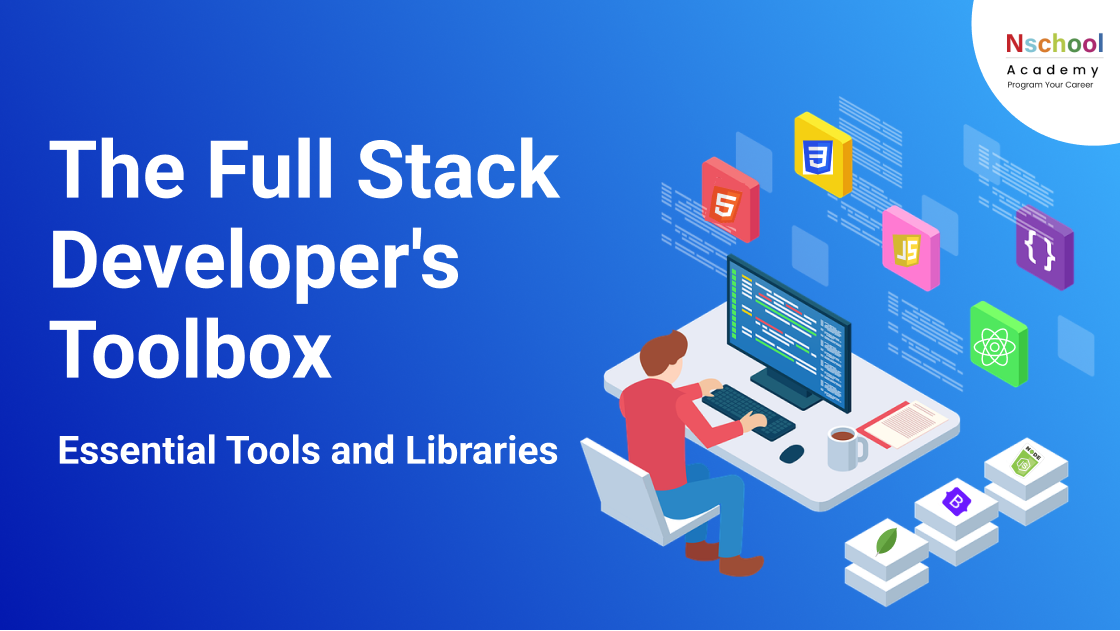- October 13, 2023
- nschool
- 0

The Full Stack Developer's Toolbox: Essential Tools and Libraries
What is Full Stack Development?
“Full-stack” refers to having all of the necessary tools and expertise to complete a task. It is referred to as a “stack.” In other words, you may create stacks for software, the Web, or phones. Most of the time, a software engineer works on either the front end or the back end. To put it another way, the entire stack includes all of the frameworks, libraries, and tools for client and server software that aid in the operation of a website or app. It includes creating code in browser languages such as JavaScript, jQuery, Angular, Vue, and others, as well as server languages such as ASP, Python, Node, PHP, and others.
What is a Full Stack Developer?
When you engage a full-stack developer, they will work on your project from beginning to end. People who work in the industry are well-versed in the many settings and interfaces, as well as the frameworks, libraries, and tools required to make an app or website run properly. As a result, full-stack writers understand both the front and back ends of the technology that powers a website. They are also well-versed in server, network, and hosting configurations, as well as languages and systems for both the front and back ends. Some full-stack developers can create websites and web applications on their own. They are familiar with front-end web-building technologies such as HTML, CSS, and JavaScript. It is also worth noting that they excel in back-end web programming languages such as Python and Ruby.
10+ Frontend and Back-end Development Tools Every Frontend and Back-end Developer Should Know in 2023
Initially, I intended to provide just ten tools, but the list has expanded, so I’ve added two more. Each instrument has many more tools and possibilities, but learning them is neither feasible nor practicable. Instead, learning one tool from each category, such as an IDE, a testing tool, a debugging tool, and a container, is sufficient. If you come across another great product that may genuinely assist Web workers in getting more done, please let us know, and I’ll add it to this list. Without further ado, here are some of the most critical technologies for web and server professionals to master in 2023:
VS Code: This tool every Web developer will need in 2023. I’ve been developing websites for a long time and have used several IDEs and editors, including Atom, Sublime, Eclipse, and IntelliJ IDEA, but VS Code is unique. It is lightweight and durable. It has an essential feature, but you may download more features to customize it to your requirements. There are several VS plugins available, including those for debugging, connecting to git, publishing to cloud services like Azure and AWS, and many more.
Postman: APIs are essential in contemporary Web development, and Postman is an excellent tool for interacting with APIs. During development, you may use Postman to connect to a third-party library by making GET and POST requests, changing request headers, inspecting response headers, and seeing additional HTTP information. Because it can be used to test REST APIs, Postman is a must-have tool for both web and server workers.
Docker: Containers are essential to the work of Web developers nowadays. Containers not only simplify development but also simplify release. Instead of starting your application and its resources independently, you install a container, which is simpler to manage and scale. Furthermore, you can only speak about containers if you mention Docker. It is one of the most well-known container systems for programmers, and Web developers must be familiar with it.
Sass: Many of you are unfamiliar with SAAS, and you may be asking whether it is the same as “SaaS” as in Microsoft 365. No, it does not. Sass is a CSS preprocessor that adds additional features to standard CSS, such as variables, stacking rules, and mixins, sometimes known as “syntactic sugar.” CSS is relatively easy to write. Even more so when viewing code authored by someone else. SASS is the solution. It assists you in writing concise, easy-to-read code.
Cloud: You should get acquainted with AWS (Amazon Web Service), Azure (from Microsoft), or GCP (Google Cloud Platform) if you still need to do so. The best one to learn is the one used by your firm. If your firm invests in Microsoft Azure, for example, you should learn how to lead your team and company by being the first to migrate your project to the cloud. Similarly, if your company migrates to GCP or Google Cloud Platform, you should learn about GCP. It’s an excellent cloud tool, particularly for firms that use Machine Learning, AI, and Big Data. If your employment requires Python Pandas, TensorFlow, or neural networks, you should learn GCP.
Jasmine: Jasmine is a user-behaviour mimicker that allows you to test your website in ways that mimic how people behave. Jasmine may be used to test the front end for readability, clickability, and how the user interface reacts to multiple screen sizes. Jasmine allows you to control how a user behaves by simulating how a user might behave utilizing customs delays and wait time.
Webpack: Webpack is a build tool that creates a dependency structure for all your files. JavaScript, images, fonts, and CSS are all included. Webpack allows you to use need() in your source code to refer to local files, such as images, and then determine how to handle them in your final Javascript bundle, such as swapping the path with a URL that goes to a CDN. Yes, Webpack will be helpful if you create a sophisticated front-end game with many non-code static assets like CSS, images, fonts, etc.
GitBash: There are several GUI and command line git programs available online, but Gitbash is the best if you use Windows and prefer to work via the command line. Even though VS Code and other IDEs currently support Github, you may choose to work at the command line, particularly if you are storing a large block of code or mixing changes from many projects. These git actions are simple on Linux but more difficult on Windows, where Gitbash comes in.
Kubernetes: When we speak about containers and Docker, Kubernetes comes up because it can assist you in managing containers. It’s simple to deploy one or two containers at first, but when your application develops and you want more instances, it isn’t easy to manually start 100 containers. It’s also a headache to build new containers and eliminate old ones. That’s where Kubernetes comes in. It is a container management solution that may help you create, grow, and handle containers.
NPM — Node Package Manager: The most essential tool for web designers. NPM is an abbreviation for “Node Package Manager.” When working on a web development project, you must utilize and import numerous additional JavaScript frameworks and libraries, such as React.js for the user interface, Vue.js for the front end, the Jest library for unit testing, and many more. With NPM, all of this is feasible. It inserts modules in the proper locations so nodes can discover and manage dependencies intelligently. It is mainly used to build, distribute, learn, and execute node software. If you enter npm help, you’ll get a list of available tools.
Chrome Developer Tools: This is yet another essential tool for Web Developers. What was going on in the computer was visible to you. Using Chrome developer tools, you may inspect various HTML elements, experiment with CSS, and test JavaScript. It also provides a wealth of information about files you’ve received, network connections, and other items. It’s a fantastic tool for browser testing, particularly for front-end developers, and you should learn how to use it before 2023.
Conclusion:
Becoming a Full Stack Developer is an exciting adventure, and you’ll need the necessary tools and resources to succeed. Learn the skills you need by enrolling in a Full Stack Developer course at Nschool Academy, a premier software training institute in Coimbatore. With their job-focused seminars and assistance in finding employment, you’ll be prepared to begin a rewarding career in Full Stack Development. Invest in your future by becoming one of the professional Full Stack Developers revolutionising the digital world.

